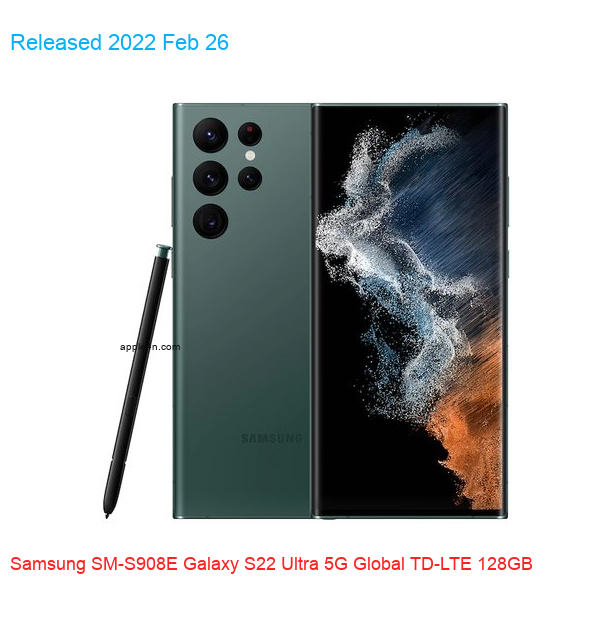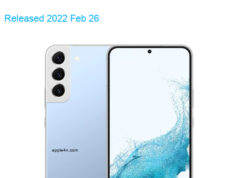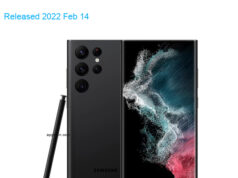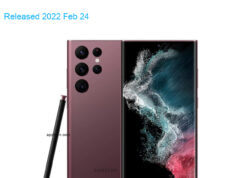| Brand | Samsung |
| Model | SM-S908E Galaxy S22 Ultra 5G Global TD-LTE 128GB |
| Released | 2022 Feb 26 |
| Announced | 2022 Feb 9 |
| Hardware Designer | Samsung Electronics |
| Manufacturer | Samsung Electronics |
| Codename | Samsung Rainbow B |
| OEM ID | S908EZGAATS |
| General Extras | Haptic touch feedback , Active stylus |
| Device Category | Smartphone |
| Width | 77.9 mm |
| Height | 163.3 mm |
| Depth | 8.9 mm |
| Dimensions | 3.07×6.43×0.35 inches |
| Mass | 228 g |
| Platform | Android |
| Operating System | Google Android 12 (S) |
| Software Extras | Voice Command , Business card recognition , Navigation software , Augmented Reality (AR) , Virtual Reality (VR) support , Intelligent personal assistant , Voice Recognition , Face Recognition |
| CPU Clock | 2995 MHz |
| CPU | Qualcomm Snapdragon 8 Gen 1 5G SM8450 (Waipio), 2021, 64 bit, octa-core, 6144 Kbyte L3, 4 nm, Qualcomm Adreno 730 GPU |
| RAM Type | LPDDR5 SDRAM |
| RAM Capacity (converted) | 8 GiB RAM |
| Non-volatile Memory Interface | UFS 3.1 |
| Non-volatile Memory Capacity (converted) | 128 GB ROM |
| Display Hole | 1-hole |
| Display Diagonal | 173.1 mm |
| Resolution | 1440×3088 |
| Horizontal Full Bezel Width | 4.74 mm |
| Display Area Utilization | 90.2% |
| Pixel Density | 500 PPI |
| Display Type | AM-OLED display |
| Display Subtype | Dynamic AM-OLED |
| Number of Display Scales | 16.8M |
| Display Refresh Rate | 120 Hz |
| Scratch Resistant Screen | Gorilla Glass Victus |
| Graphical Controller | Qualcomm Adreno 730 |
| GPU Clock: | 818 MHz |
| A/V Out | DisplayPort |
| Microphone(s) | stereo |
| Loudspeaker(s): | stereo |
| Audio Output: | USB Type-C |
| Supported Cellular Bands | GSM850 , GSM900 , GSM1800 , GSM1900 , UMTS2100 (B1) , UMTS1900 (B2) , UMTS1700/2100 (B4) , UMTS850 (B5) , UMTS900 (B8) , LTE2100 (B1) , LTE1900 (B2) , LTE1800 (B3) , LTE1700/2100 (B4) , LTE850 (B5) , LTE2600 (B7) , LTE900 (B8) , LTE700 (B12) , LTE700 (B13) , LTE700 (B17) , LTE800 (B18) , LTE800 (B19) , LTE800 (B20) , LTE1900 (B25) , LTE850 (B26) , LTE700 (B28) , TD-LTE2600 (B38) , TD-LTE1900 (B39) , TD-LTE2300 (B40) , TD-LTE2500 (B41) , LTE1700/2100 (B66) , NR2100 (N1) , NR1900 (N2) , NR1800 (N3) , NR850 (N5) , NR2600 (N7) , NR900 (N8) , NR 700 (N12) , NR800 (N20) , NR1900 (N25) , NR700 (N28) , TD-NR2600 (N38) , TD-NR2300 (N40) , TD-NR2500 (N41) , NR1700/2100 (N66) , TD-NR3700 (N77) , TD-NR3500 (N78) bands |
| Supported Cellular Data Links | GPRS , GPRS C12 , GPRS MSC33 , EDGE , EDGE MSC12 , UMTS , HSUPA , HSUPA 5.8 , HSDPA , HSPA+ 21.1 , DC-HSDPA 42.2 , LTE , LTE 100/50 , LTE 150/50 , LTE 300/50 , LTE 300/75 , LTE 300/100 , LTE 400/150 , LTE 450/50 , LTE 450/100 , LTE 600/50 , LTE 600/100 , LTE 1000/100 , LTE 1200/200 , LTE 1600 , LTE 2000/300 , NR 1500 , NR 2600 , NR 3700 data links |
| SIM Card Slot | e-SIM , Nano-SIM (4FF) |
| Complementary Phone Services | Voice transmission , Voice speaker , Vibrate , Speakerphone , ANC , HD Voice , VoLTE , ViLTE |
| SAR (head) | 1.243 W/kg |
| SAR (body) | 1.266 W/kg |
| Sec. Supported Cellular Networks: | No |
| Touchscreen Type | Capacitive multi-touch screen |
| Expansion Interfaces | No |
| USB | USB 3.0 / 3.1 Gen 1 / 3.2 Gen 1×1 |
| USB Services | USB charging , USB fast charging , USB Host , USB OTG 1.3 , USB OTG 2.0 , USB PD , USB PD 2.0 , USB PD 3.0 |
| USB Connector | USB C reversible |
| Max. Charging Power | 45.0 W |
| Bluetooth | Bluetooth 5.2 |
| Wireless LAN | 802.11a , 802.11b , 802.11g , 802.11n , 802.11ac , 802.11ax |
| Wireless Services | DLNA , Miracast , Wi-Fi Direct , Wi-Fi Tethering , WiDi , Wi-Fi Calling |
| NFC | NFC A , NFC B |
| FM Radio Receiver | No |
| Complementary Satellite Services | Simultaneous GPS , A-GPS , Dual-frequency GPS , Geotagging , QuickGPS , QZSS |
| Supported GLONASS protocol(s) | L1OF , L2OF |
| Supported Galileo service(s) | E1 , E5a |
| Supported BeiDou system (BDS) | B1I , B2a BeiDou receiver |
| Camera Placement | Rear |
| Camera Image Sensor | BSI CMOS |
| Image Sensor Pixel Size | 0.80 micrometer |
| Number of effective pixels | 108.0 MP camera |
| Aperture (W) | f/1.80 |
| Zoom | 10.0 x optical zoom |
| Focus | PD AF , Laser AF |
| Min. Equiv. Focal Length | 24 mm |
| Video Recording | 7680×4320 pixel |
| Flash | single LED |
| Camera Extra Functions | EIS , EIS (video) , OIS , OIS (video) , Pixel unification , HDR photo , HDR video , Red-eye reduction , Slow motion video , Burst mode , Refocus , Touch focus , Macro mode , Panorama Photo , Face detection , Face tagging , Smile detection , Face retouch , Face retouch (video) , Intelligent scene detection |
| Aux. Camera Image Sensor | BSI CMOS |
| Aux. Cam. Image Sensor Pixel Size | 1.40 micrometer |
| Aux. Camera Number of Pixels | 12.2 MP aux. cam |
| Aux. Camera Aperture (W) | f/2.20 |
| Aux. Cam. Min. Equiv. Focal Length | 13 mm |
| Aux. Camera Focus | PD AF |
| Aux. Camera Extra Functions | EIS (video) , HDR photo , HDR video , Slow motion video , Burst mode , Touch focus , Macro mode , Panorama Photo , Face detection , Face tagging , Smile detection , Face retouch , Face retouch (video) , Intelligent scene detection |
| Aux. 2 Camera Image Sensor | BSI CMOS |
| Aux. 2 Camera Number of Pixels | 10.0 MP aux. 2 cam |
| Aux. 2 Camera Aperture (W) | f/2.40 |
| Aux. 2 Cam. Min. Equiv. Focal Length | 69 mm |
| Aux. 3 Camera Image Sensor | BSI CMOS |
| Aux. 3 Camera Number of Pixels | 10.0 MP aux. 3 cam |
| Aux. 3 Camera Aperture (W) | f/4.90 |
| Aux. 3 Cam. Min. Equiv. Focal Length | 240 mm |
| Aux. 4 Camera Image Sensor | No |
| Secondary Camera Placement | Front |
| Secondary Camera Sensor | BSI CMOS |
| Secondary Camera Number of pixels | 39.9 MP sec. cam |
| Secondary Aperture (W) | f/2.20 |
| Secondary Camera Focus | PD AF |
| Secondary Video Recording | 3840×2160 pixel |
| Secondary Camera Extra Functions | Pixel unification , HDR photo , HDR video , Slow motion video , Burst mode , Touch focus , Panorama Photo , Face detection , Face tagging , Smile detection , Face retouch , Face retouch (video) , Intelligent scene detection |
| Sec. Aux. Cam. Image Sensor | No |
| Built-in compass | 3D compass |
| Built-in accelerometer | 3D accelerometer |
| Built-in gyroscope | 3D gyro |
| Additional sensors | Barometer , In-screen FP sensor , Hall , HR sensor , L sensor , P sensor , Step counter |
| Protection from solid materials | 6 Totally protected from dust |
| Protection from liquids | 8 Protected against immersion beyond 1m of depth |
| Immersion into liquids (depth limit) | 150 cm |
| Immersion into liquids time limit | 30 min |
| Battery | Li-ion |
| Nominal Battery Voltage | 3.88 Volts |
| Nominal Battery Capacity | 5000 mAh battery |
| Nominal Battery Energy | 19.40 Wh |
| Estimated Battery Life | 18.0 hours |
| Talk Time: | 36.0 hours |
| Wireless Charging | PMA , Qi |
| Max. Wireless Charging Power | 15.0 W |
| Market Countries | Australia , NZ , Peru |
| Market Regions | Australia , Europe , South America |
| Mobile Operator | Claro Peru Movistar Peru SingTel Optus Pty Limited Telstra Corporation Limited Vodafone Australia |
| Price | 1799 unknown |
Specifications data description of this 📱Samsung SM-S908E Galaxy S22 Ultra 5G Global TD-LTE 128GB📱
Title: Samsung SM-S908E Galaxy S22 Ultra 5G Global TD-LTE 128GB: A Comprehensive Specification Overview 📱
Introduction:
Welcome to our latest blog post, where we delve into the details of the Samsung SM-S908E Galaxy S22 Ultra 5G Global TD-LTE 128GB, the newest addition to the Samsung Galaxy family. This post will provide an in-depth look at the device’s specifications, touching upon key aspects of its design, performance, connectivity, and more. So, let’s dive right in! 🌊
Lineup 📈:
The Samsung Galaxy S22 Ultra is the most premium device in Samsung’s latest S series lineup, offering impressive features and power-packed performance. This smartphone raises the bar for mobile technology with its refined design, innovative features, and cutting-edge specifications.
Design 🏆:
With a sleek, premium design, the Samsung Galaxy S22 Ultra stands out from the crowd. The device boasts a large, immersive 6.8-inch Dynamic AMOLED 2X display 🌈 with a high resolution (3088 x 1440) and a smooth 120Hz refresh rate for a seamless viewing experience. The device also houses an embedded S Pen 🖋️ for convenient note-taking and drawing, setting it apart from other devices in its class.
Specifications 🔧:
Let’s take a closer look at the device’s specifications:
🌐 Network: 5G, GSM, HSPA+, TD-LTE
📅 Launch: 2022, February
🏋️ Body: 163.3 x 77.9 x 8.9mm (6.43 x 3.07 x 0.35 in), 229g (8.09 oz)
🌈 Display: 6.8-inch Dynamic AMOLED 2X, 120Hz refresh rate, HDR10+, 1750 nits (peak)
🤖 OS: Android 12, One UI 4.0
🛠️ Chipset: Exynos 2200 (EU) / Snapdragon 8 Gen 1 (USA)
💪 CPU: Octa-core (1×3.0 GHz Cortex-X2 & 3×2.5 GHz Cortex-A710 & 4×1.7 GHz Cortex-A510)
🎮 GPU: Xclipse 920 (EU) / Adreno 730 (USA)
🧠 Memory: 128GB 8GB RAM / 256GB 12GB RAM / 512GB 12GB RAM / 1TB 12GB RAM
📷 Camera: Quad rear cameras (108MP * 12MP * 10MP * 12MP) / Front camera (40MP)
🔈 Sound: Stereo speakers
📡 Communications: Wi-Fi 802.11 a/b/g/n/ac/6e, Bluetooth 5.2, GPS, NFC, USB Type-C 3.2
💡 Features: Ultrasonic Fingerprint Sensor, Face Unlock, IP68 dust/water resistance, Samsung Pay, Samsung DeX
🔋 Battery: 5000mAh, Fast charging 45W, Fast wireless charging 15W, USB Power Delivery 3.0, Reverse wireless charging 4.5W
Conclusion 🎉:
In a nutshell, the Samsung SM-S908E Galaxy S22 Ultra 5G Global TD-LTE 128GB is a feature-rich device that combines stunning design, powerful performance, and innovative features in a single package. With its high-resolution display, cutting-edge processor, impressive cameras, and long-lasting battery, it offers a premium mobile experience.
What are your thoughts on the Samsung Galaxy S22 Ultra? Don’t forget to leave a comment below and share this post with your friends who might be interested in learning more about this outstanding device. We appreciate your feedback, and please stay tuned for more exciting content! 🚀
[END]








